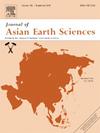青藏高原北部东昆仑造山带哈图蛇绿岩年代学与地球化学:对原特提斯洋的约束
IF 2.7
3区 地球科学
Q2 GEOSCIENCES, MULTIDISCIPLINARY
引用次数: 0
摘要
出露于青藏高原北部东昆仑造山带(E-KOB)阿其库勒湖-昆仲蛇绿岩混杂带的早古生代蛇绿岩,为研究原特提斯洋的构造演化和东昆仑造山带的俯冲-成因过程提供了重要线索。哈图蛇绿混杂岩包含一系列蛇绿岩块和基质(元)碎屑岩。详细的实地调查显示,这些被称为哈图蛇绿岩的蛇绿岩块由辉长岩、辉绿岩和玄武岩组成。所有岩浆岩的特征都是总 REE 值低(22.61-45.92 ppm)、金刚石归一化 REE 模式平坦、LREEs 轻微富集((La/Yb)N = 1.07-1.28)。辉长岩和玄武岩的锆石εHf(t)正值范围分别为+ 11.72至+ 14.29和+ 4.10至+ 10.93。地球化学数据表明,所有岩浆岩都具有正常大洋中脊玄武岩(N-MORB)的特性,其母岩源自贫化地幔源。锆石 U-Pb 测定结果显示,两个辉长岩样本的加权平均年龄一致,分别为 421 ± 2.9 Ma 和 426 ± 4.9 Ma,而玄武岩的加权平均年龄为 426 ± 5.9 Ma,表明蛇绿岩的岩浆成分形成于 426-421 Ma。包括综合地质、地球化学和年代学数据在内的全面证据表明,哈图蛇绿混杂岩的辉长岩、辉绿岩和玄武岩块很可能是具有 N-MOR 亲缘关系的早古生代海洋碎块。新证据表明,E-KOB 地区的原特提斯洋在志留纪经历了洋中脊扩张。本文章由计算机程序翻译,如有差异,请以英文原文为准。
Geochronology and geochemistry of the Hatu ophiolite in the East Kunlun Orogenic Belt, northern Tibetan Plateau: Constraints on the Proto-Tethys Ocean
The Early Paleozoic ophiolites exposed within the Aqikekulehu-Kunzhong ophiolitic mélange zone of the East Kunlun Orogenic Belt (E-KOB) in the northern Tibetan Plateau offer vital clues regarding the tectonic evolution of Proto-Tethys Ocean and subduction-accretionary process of the E-KOB. The Hatu ophiolitic mélange, contains a series of ophiolitic blocks and matrix (meta-) clastic rocks. Detailed field investigations reveal that the ophiolitic blocks, termed as the Hatu ophiolite, consist of gabbro, diabase and basalt. All of the mafic rocks are featured by low total REE (22.61–45.92 ppm), the flat chondrite-normalized REE patterns, slight LREEs enrichment with (La/Yb)N = 1.07–1.28. The positive zircon εHf(t) values of the gabbro and basalt range from + 11.72 to + 14.29 and from + 4.10 to + 10.93, respectively. Geochemical data indicates that all mafic rocks exhibit normal mid-ocean ridge basalt (N-MORB) properties, with their parental magmas originating from a depleted mantle source. Zircon U-Pb dating results show that two gabbro samples yield consistent weighted mean ages of 421 ± 2.9 Ma and 426 ± 4.9 Ma, while the weighted mean age of basalt is 426 ± 5.9 Ma, indicating the magmatic component of the ophiolite was formed at 426–421 Ma. The comprehensive evidence, encompassing integrated geological, geochemical and chronological data, suggests that the gabbro, diabase and basalt blocks of Hatu ophiolite are most likely the Early Paleozoic oceanic fragments having N-MOR affinities. The new evidence indicates that the Proto-Tethys Ocean in the E-KOB experienced mid-ocean ridge spreading during the Silurian.
求助全文
通过发布文献求助,成功后即可免费获取论文全文。
去求助
来源期刊

Journal of Asian Earth Sciences
地学-地球科学综合
CiteScore
5.90
自引率
10.00%
发文量
324
审稿时长
71 days
期刊介绍:
Journal of Asian Earth Sciences has an open access mirror journal Journal of Asian Earth Sciences: X, sharing the same aims and scope, editorial team, submission system and rigorous peer review.
The Journal of Asian Earth Sciences is an international interdisciplinary journal devoted to all aspects of research related to the solid Earth Sciences of Asia. The Journal publishes high quality, peer-reviewed scientific papers on the regional geology, tectonics, geochemistry and geophysics of Asia. It will be devoted primarily to research papers but short communications relating to new developments of broad interest, reviews and book reviews will also be included. Papers must have international appeal and should present work of more than local significance.
The scope includes deep processes of the Asian continent and its adjacent oceans; seismology and earthquakes; orogeny, magmatism, metamorphism and volcanism; growth, deformation and destruction of the Asian crust; crust-mantle interaction; evolution of life (early life, biostratigraphy, biogeography and mass-extinction); fluids, fluxes and reservoirs of mineral and energy resources; surface processes (weathering, erosion, transport and deposition of sediments) and resulting geomorphology; and the response of the Earth to global climate change as viewed within the Asian continent and surrounding oceans.
 求助内容:
求助内容: 应助结果提醒方式:
应助结果提醒方式:


